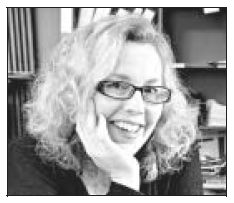
Through a casual exchange of emails a few weeks ago, Deb Cashion alerted me to a recent article “Police chase DNA of Elmer Crawford relatives in Northern Ireland” that appeared in the Herald Sun. It described the Victoria police search for a DNA family reference for Crawford.
Since I was traveling in Ireland at the time, I offered to help locate the required reference. Deb put me in touch with Keith Moor, the Insight Editor of the Herald Sun, an award-winning journalist and the author of the article. Keith forwarded me two new articles that appeared in the Sun on July 14 “Mystery man was a drifter” and July 15 “Police chase tip to retrieve DNA” that provided more information on the case.
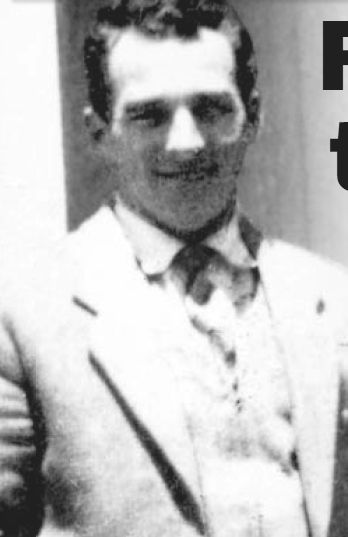
According to the articles, authories were searching for Crawford family members who could serve as DNA references for Elmer. The object was to compare family DNA to that of an unidentified man who had died in a Texas hospital in 2005 who was thought to be Elmer.
Under normal circumstances, Y-DNA would have been used to confirm the Texan as Elmer. Because the Y-chromosome follows the male line of a family as does the family name in western cultures, a Y-DNA match offers the most straightforward method of identifying an unknown male. Elmer could have aged, he could be living under an assumed name, or he even could have had cosmetic surgery to alter his appearance, but he could not have changed his DNA.
Y-DNA matching could not be done in the present case, however, because Elmer was illegitimate of unknown paternity, had no known brothers, and his son was dead. (He killed him). There were no males who would qualify as a Y-DNA reference, so that mitochondrial DNA (mtDNA) would have to be used instead. Because this type of DNA is handed down along the direct female line of a family, it can be difficult to locate a family member who can serve as an mtDNA reference because the name changes in each generation.
In my experience, the key to success in soliciting someone to give a DNA sample is being well prepared with information about his family pedigree. My first step was to learn as much about Elmer himself as I could.
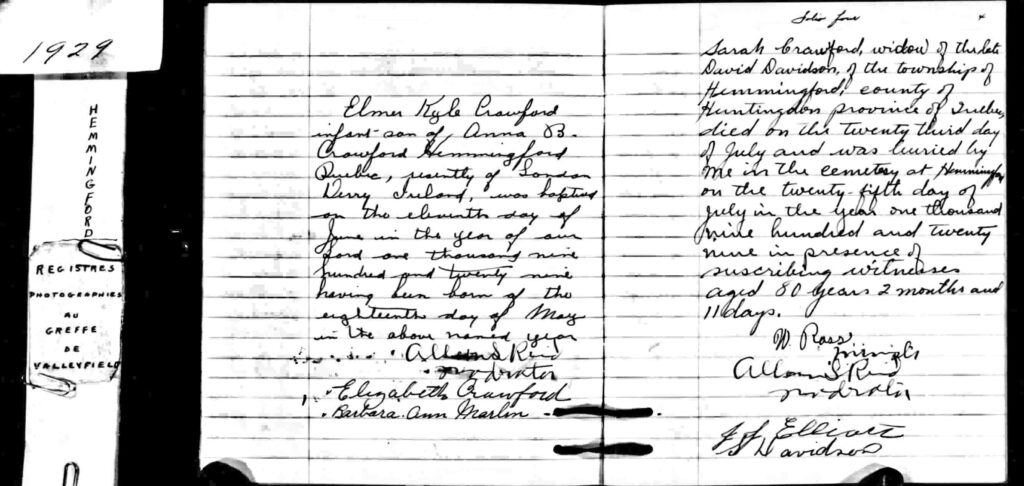
Elmer was born 18 May 1929 in Quebec, Canada, the son of Anna B. Crawford and an unknown father. His mother traveled to Canada from Tamneymartin, Maghera Parish, Co. Derry, Ireland, to give birth to Elmer. This information allowed me to locate his baptismal record in the Drouin Collection, the largest repository of French Canadian church records. He was baptized 11 June 1929 in Hemmingford, Quebec. One of his baptismal sponsors was his maternal grandmother Elizabeth Crawford. The Sarah Crawford whose burial record appears on the page following Elmer’s baptismal record was probably a relative, perhaps the reason Elmer was born in Hemmingford.
During a brainstorm, I emailed the Maghera District Genealogy and History Society for “Help with a Murder Case”. An immediate response came from Society member Denver Boyd, “We don’t normally get emails as dramatic as yours!”
Denver provided a pedigree of the Crawford family. It seemed ordinary even though one of its branches ended with a cold-blooded killer. He also provided me with the contact information of Gilbert Crawford, a local businessman, auctioneer, and Justice of the Peace. He is also Anna B. Crawford’s nephew. If anyone knew everyone, it would be Gilbert.
In the next few days, with the help of Denver and Gilbert, I discovered that Anna’s sisters had not married and had had no children. It was time to research one generation back, with the hope of finding a female line that had survived.

Elizabeth Kyle Crawford’s family was large. She had four sisters and three brothers. It seemed there was ample probability of success. Yet according to the family chart, of those four sisters, the only one to marry besides Elizabeth was her younger sister Charlotte. Charlote had had three sons and one daughter Kathleen, but Kathleen was deceased and had had no children. I was back to square one.
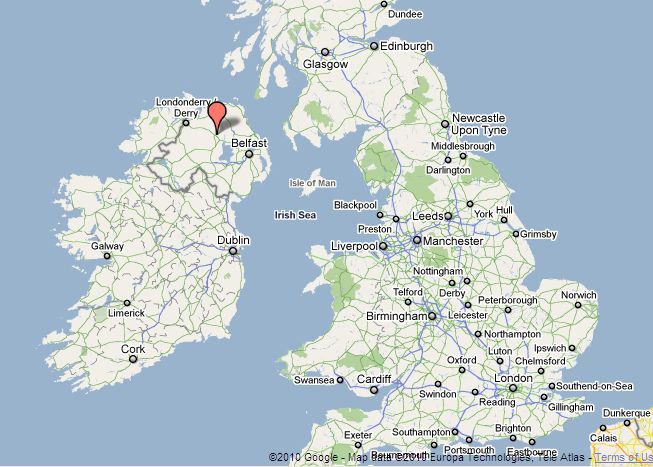
In a foreign country, internet access can be difficult when you are staying in B&B’s as we were. Libraries usually have terminals for their patrons to check email and surf the web, but it is usually not possible to connect your laptop to their server. If you have to send email attachments, libraries are not much use to you. Drogheda, the largest town near the village where were were staying, did not have an internet cafe, but we were lucky to discover a hotel where I could purchase broadband access. Since my cell phone did not work in Ireland, my personal calls to the Crawford family had to be made over Skype from the hotel. This was a quiet and comfortable arrangement, but it did not allow anyone to call me back.
Nevertheless a lucky mistake led to the sought-after mtDNA reference. After speaking to Gilbert’s sister June, the Crawford family genealogist, I discovered that I had forgotten to ask her for a certain phone number. I was glad I called her back. June had just located her genealogical documents, and discovered that Elizabeth’s sister Sarah had not died in 1901, as indicated by the family chart. The notation shown in the chart was only an abbreviation. The attached pedigree that I had ignored revealed that Sarah had died after 1901. June discovered that Sarah had married, had had two daughters and a son, had lived until April 1979 and that Sarah’s granddaughter Lois still lives in Maghera Parish. By coincidence Lois’ daughter Sheelagh lives in New South Wales, Australia making it convenient for the Victoria police to contact her for a DNA sample.
Although it sounds as if everything fell into place at one time, it took me several days to work out the family connections. We were traveling, and the hotel internet proved too expensive for everyday use. Luckily we discovered that the local McDonald’s offered free internet access with the purchase of a cup of coffee. Free parking was included. Over the next few days, we drank a lot of McDonald’s coffee as I emailed to Keith Moor and the Victoria police Sheelagh’s contact information and the documentation confirming her as Elmer Kyle Crawford’s mtDNA reference. My job was done.
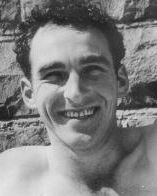
It took a few weeks for the authorities to obtain a DNA sample from Sheelagh, analyze it, and discover it did not match the man who died in the Texas hospital. The man in the hospital is still unidentified, and Elmer Kyle Crawford, who so brutally murdered his young family in 1970, is still at large.
If you have any information on the whereabouts of Elmer Kyle Crawford, please contact me at colleen@identifinders.com. You may remain anonymous.

8 Responses
My name is Betty Cloud Anstis, daughter of Anna Beatrice Crawford Cloud. Elmer is my half-brother. Am sending you a separate more detailed email. Thank you for your continued effort and concern.
Hi Betty, Thanks for writing in. We managed to get a DNA sample from a member of his mother’s family in Ireland who is now living in Australia. Her DNA did not match the DNA of the individual we believed was Elmer. The hunt for Elmer is still ongoing. I will answer your email separately. Colleen
Hello Coleen, I’m Trisha and I am Elmer’s daughter. We may have been in contact before. I was looking at the family tree and the name next to Anna(my grandmother) is Leonard Stockman. The line leads down to Elmer. Is this man Elmer father? Please advise.
Trisha
Trisha,
The information contained in the Crawford family tree came from Denver Boyd, at the Maghera District Genealogy and History Society. I am searching for his contact info, but you may get it more quickly by Googling him on the internet. Denver did not provide any documentation, but it did not matter because Elmer has no direct male descendants to test. I don’t remember where the name Leonard Stockman comes from – Denver would have that.
Good luck!
Colleen
Hi Colleen,
I have to say that I am confused about the DNA concerning Elmer Crawford. I say this because a member of my family is about to do a DNA test to confirm if he is my brother’s son. It sounds as though that the distant relative would be further down the scale of accuracy. The DNA company who are doing it say that a close relative gives a more accurate reading. Given that I am Elmer Crawford’s daughter and Betty is his half sister, wouldn’t it have been better to have taken our DNA to decide the outcome. Betty and I offered but were turned down. I found the whole thing very odd.
Hi Trisha,
I believe you are referring to a Y-DNA test when you say that a member of your family is testing to confirm he is your brother’s son. This is one test that can help confirm that a man is related along the direct male line to another man, although the test is usually not so specific to designate them as a father-son pair. The test can, however, rule out a relationship if the Y-DNA of the two men does not match.
In Elmer’s case, a Y-test was not possible since he had no known male relatives. He killed his son, and his father was unknown. The Y-test you could be referring to would not apply when trying to verify if the man in the hospital was Elmer himself, because there was no known living male Crawford family member to which Elmer’s Y-DNA could be compared.
Instead, we used an mtDNA family reference we located from his mother’s side of the family. This test can confirm a relationship between two people along the direct female line of a family. Although it cannot specify the exact relationship between two individuals who match, it can rule out a relationship between two individuals who don’t match. In the present case, there was no match. The man in Texas was not Elmer Crawford.
The test you seem to refer to that “gives a better reading when applied to a closer family member” is the autosomal DNA test. That kind of test was not available back when we were looking for a family reference to verify the identity of the man in the Texas hospital.
Even so, DNA testing should be accompanied by written documentation – that is, a birth or death certificate, a will, etc, that establishes the family member’s relationship to the deceased. It’s been a while since all this happened, but I recall there was a question about whether your mother Betty is Elmer’s half sister. I believe I was in touch with her at the time and suggested she submit her birth certificate or some other form of documentation to confirm the relationship, but I did not hear back from her. If she is linked to Elmer through a common father, no Y-DNA testing could have been done since she is not a male (no Y-DNA) and mtDNA testing would not have worked either since she would not have shared a common mother with Elmer. If Betty is linked to Elmer through the same mother, she could have been the mtDNA reference had she produced the documentation.
Another possibility is a paternity test using CODIS markers, the same markers the authorities use for forensic identification. This might also be the test you are using to establish the identity of your “nephew”. This kind of test is only good for very close family members, and using Betty as Elmer’s half-sister would probably have not been accurate enough to be useful especially without the documentation she needed to show she was Elmer’s half sister.
We were able to prove that the man in the hospital was not Elmer through a maternally-linked cousin in Australia who could document her relationship to Elmer. She was his niece. There was no uncertainty about this, so it was straightforward to use her as an mtDNA reference. We could not use your mother for the reasons I cite above.
If you wish to go ahead with the autosomal test, you will have to get one of the known Crawford relatives to test with you so you can compare whether the estimate of your relationship with that relative is consistent with what your genealogy gives you. But this would only be to put your own mind at rest. There’s no reason to test again unless someone else is located who might be Elmer. And if that happens, we already have an mtDNA reference that could be used for the comparison.
Colleen
No one ever contacted me asking for a birth certificate or any other documentation. My birth certificate shows my mother as Anna Beatrice Crawford Cloud. Elmer and I share a mother. It is not important to me to prove my relationship unless it can aid in the identity and/or apprehension of Elmer. I appreciate being kept in the loop of information and will be anxious to receive further notices. Betty Cloud Anstis
Betty,
My responsibility to the authorities on this case was to find a mitochondrial DNA reference to either prove or rule out that the man in Texas was Elmer Crawford. I was routed to a family member who directed me to such a maternally-linked relative in Australia. It was not my responsibility to find all the members of the family and select “the best” one to be the reference, since there is no best one. All maternally linked relatives are equivalent. I turned in the name of the first person I found who met the requirements.
I am sorry you were not contacted, but that is something to discuss with your family.
If you are interested in being kept in the loop, I suggest you stay in touch with your family, especially your cousin in Australia, as she will be the one contacted if there is any more activity on the case. I will almost certainly not be involved, since the authorities do not need another mitochondrial DNA reference. They already have one.
Colleen